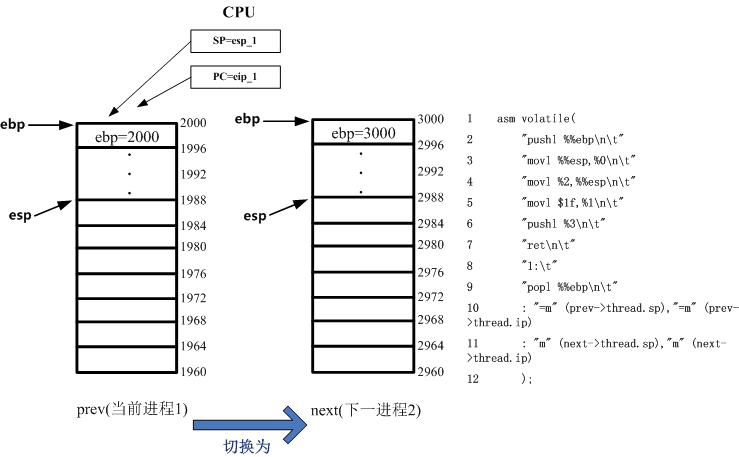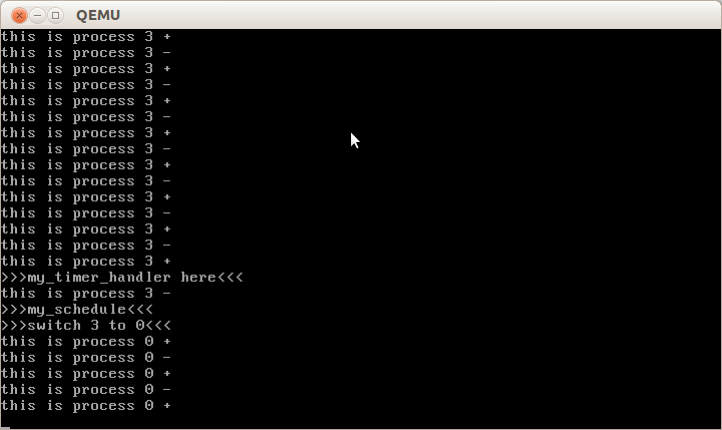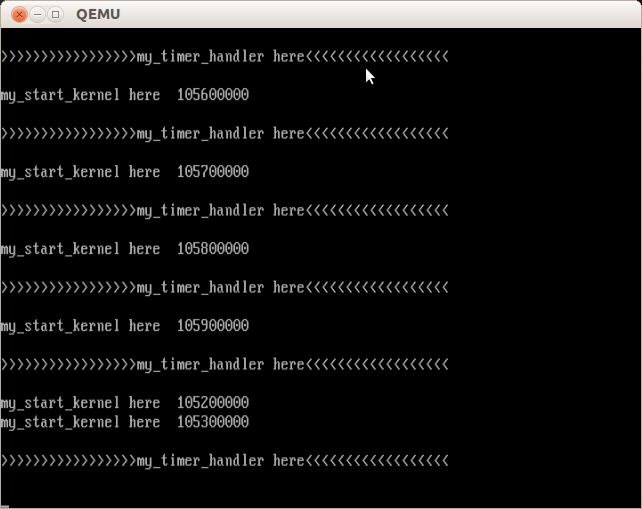Linux内核课第二作业。本文在Ubuntu 12.04中完成
唐国泽 原创作品转载请注明出处 《Linux内核分析》MOOC课程http://mooc.study.163.com/course/USTC-1000029000
--------------------------------------------------------分割线----------------------------------------------------------------------------------------------------
一.计算机是如何工作的(小结)
计算机的工作,一言以蔽之:执行程序的过程;也就是存储程序和程序控制的过程。
-
存储程序计算机工作模型,计算机系统最最基础性的逻辑结构;
-
函数调用堆栈,高级语言得以运行的基础;
-
中断,多道程序操作系统的基点。
二.以例分析
1.一个简单的中断的例子(点击进入)
简要分析mymain.c与myinterrupt.c
- void __init my_start_kernel(void) //mymain.c中主要内容
- {
- int i = 0;
- while(1)
- {
- i++;
- if(i%100000 == 0) //每循环十万次打印一次my_start_kernel here
- printk(KERN_NOTICE "my_start_kernel here %d \n",i);
- }
- }
- void my_timer_handler(void) //每次时钟中断调用一次 myinterrupt.c中主要内容
- {
- printk(KERN_NOTICE "\n>>>>>>>>>>>>>>>>>my_timer_handler here<<<<<<<<<<<<<<<<<<\n\n");
- }
可见,这只是一个很简单的时钟中断演示实验,执行结果如下所示:
可以清楚的看到,时钟每记数到十万的时候,打印一个my_start_kernel here,时钟中断的时候执行my_time_hander here.
2.在第一个的基础上进行时间片轮转多道程序的小os.
主要对mypcb.h, mymain.c 和myinterrupt.c这三个文件进行分析。
/ * linux/mykernel/mypcb.h
* Kernel internal PCB types
* Copyright (C) 2013 Mengning
*/
#define MAX_TASK_NUM 4
#define KERNEL_STACK_SIZE 1024*8
/* CPU-specific state of this task */
- struct Thread {//给任务定义一个eip和esp
- unsigned longip;
- unsigned longsp;
- };
- typedef struct PCB{
- int pid;//任务编号
- volatile long state;/* -1 unrunnable, 0 runnable, >0 stopped */
- char stack[KERNEL_STACK_SIZE]; //定义栈空间
- /* CPU-specific state of this task */
- struct Thread thread; //定义进程的结构体thread, 其中有eip和esp
- unsigned longtask_entry;//任务的函数起始处, 也就是任务第一次执行的起始位置
- struct PCB *next;//一个任务链表, 指向下一个任务
- }tPCB;
- void my_schedule(void);//任务调动函数
/* linux/mykernel/mymain.c
* Kernel internal my_start_kernel
* Copyright (C) 2013 Mengning
*/
#include <linux/types.h>
#include <linux/string.h>
#include <linux/ctype.h>
#include <linux/tty.h>
#include <linux/vmalloc.h>
#include "mypcb.h" //引入其中两个结构体表示
- tPCB task[MAX_TASK_NUM];//定义两个数组
- tPCB * my_current_task = NULL;
- volatile int my_need_sched = 0;//定义是否调度, 1则调度, 0则不调度
- void my_process(void);
- void __init my_start_kernel(void) //起始函数位置
- {
- int pid = 0;
- int i;
- /* Initialize process 0*/
- task[pid].pid = pid;
- task[pid].state = 0;/* -1 unrunnable, 0 runnable, >0 stopped */
- task[pid].task_entry = task[pid].thread.ip = (unsigned long)my_process;
- task[pid].thread.sp = (unsigned long)&task[pid].stack[KERNEL_STACK_SIZE-1]; //0号进程栈在最开始的位置
- task[pid].next = &task[pid];//下一个任务也是自己,在这里,其他任务还没有创建
- /*fork more process *///创建多个任务
- for(i=1;i<MAX_TASK_NUM;i++)
- {
- memcpy(&task[i],&task[0],sizeof(tPCB));//复制0号进程的结构形式
- task[i].pid = i;
- task[i].state = -1;//初始的任务(除0号进程外)都设置成未运行
- task[i].thread.sp = (unsigned long)&task[i].stack[KERNEL_STACK_SIZE-1];
- task[i].next = task[i-1].next;//新fork的进程加到进程链表的尾部, 该新建任务的next指向上一个任务的next,也就是自己(最后一个)
- task[i-1].next = &task[i]; //配置上一个任务的next指向这时候新创建的任务
- }
- /* start process 0 by task[0] */
- pid = 0;
- my_current_task = &task[pid];//先让0号进程先执行
- asm volatile(
- "movl %1,%%esp\n\t" /* set task[pid].thread.sp to esp */
- "pushl %1\n\t" /* push ebp ,当前esp=ebp*/
- "pushl %0\n\t" /* push task[pid].thread.ip */
- "ret\n\t" /* pop task[pid].thread.ip to eip */
- "popl %%ebp\n\t"
- :
- : "c" (task[pid].thread.ip),"d" (task[pid].thread.sp)/* input c or d mean %ecx/%edx*/
- );
- }
- void my_process(void)
- {
- int i = 0;
- while(1)
- {
- i++;
- if(i%10000000 == 0)
- {
- printk(KERN_NOTICE "this is process %d -\n",my_current_task->pid);
- if(my_need_sched == 1)//判断是否调度;该值可有itnerrupt.c中的函数来配置
- {
- my_need_sched = 0;
- my_schedule(); //主动调动的机制
- }
- printk(KERN_NOTICE "this is process %d +\n",my_current_task->pid);
- }
- }
- }
/* linux/mykernel/myinterrupt.c
* Kernel internal my_timer_handler
* Copyright (C) 2013 Mengning
*/
#include <linux/types.h>
#include <linux/string.h>
#include <linux/ctype.h>
#include <linux/tty.h>
#include <linux/vmalloc.h>
#include "mypcb.h"
extern tPCB task[MAX_TASK_NUM];
extern tPCB * my_current_task;
extern volatile int my_need_sched;
volatile int time_count = 0;
/*
* Called by timer interrupt.
* it runs in the name of current running process,
* so it use kernel stack of current running process
*/
- void my_timer_handler(void)
- {
- #if 1
- if(time_count%1000 == 0 && my_need_sched != 1)//时钟中断1000次的时候,调度一次, 配置调度值为1
- {
- printk(KERN_NOTICE ">>>my_timer_handler here<<<\n");
- my_need_sched = 1;
- }
- time_count ++ ;
- #endif
- return;
- }
- void my_schedule(void) //调度函数, 核心函数
- {
- tPCB * next;//定义两个指针
- tPCB * prev;
- if(my_current_task == NULL //当前进程和下一进程为空, 即没有任务, 返回
- || my_current_task->next == NULL)
- {
- return;
- }
- printk(KERN_NOTICE ">>>my_schedule<<<\n");
- /* 在调度函数中, next指向的是下一个将要被调度的任务, prev指向的是当前正在运行的任务*/
- /* schedule */
- next = my_current_task->next;//把当前进程的下一个进程赋值给next,当前进程赋值给prev
- prev = my_current_task;
- if(next->state == 0)/* -1 unrunnable, 0 runnable, >0 stopped */ //如果下一个任务不是第一次被调度, 则执行
- {
- /* switch to next process——这个时候下一个进程有进程上下文 */
- asm volatile(
- "pushl %%ebp\n\t" /* save 当前进程 ebp */
- "movl %%esp,%0\n\t" /* save 当前 esp 赋值到prev.thread.sp */
- "movl %2,%%esp\n\t" /* restore 下一个进程的sp到 esp */
- "movl $1f,%1\n\t" /* save 当前进程的 eip */
- "pushl %3\n\t" //保存下一个进程eip保存到栈里面
- "ret\n\t" /* restore eip */
- "1:\t" /* next process start here */
- "popl %%ebp\n\t"
- : "=m" (prev->thread.sp),"=m" (prev->thread.ip)
- : "m" (next->thread.sp),"m" (next->thread.ip)
- );
- my_current_task = next;
- printk(KERN_NOTICE ">>>switch %d to %d<<<\n",prev->pid,next->pid);
- }
- else//下一个进程为第一次运行时,没有进程上下文, 则以下面这种方式来处理
- {
- next->state = 0;
- my_current_task = next;
- printk(KERN_NOTICE ">>>switch %d to %d<<<\n",prev->pid,next->pid);
- /* switch to new process */
- asm volatile(
- "pushl %%ebp\n\t" /* save ebp */
- "movl %%esp,%0\n\t" /* save esp */x`
- "movl %2,%%esp\n\t" /* restore esp */
- "movl %2,%%ebp\n\t" /* restore ebp */
- "movl $1f,%1\n\t" /* save eip */
- "pushl %3\n\t"
- "ret\n\t" /* restore eip */
- : "=m" (prev->thread.sp),"=m" (prev->thread.ip)
- : "m" (next->thread.sp),"m" (next->thread.ip)
- );
- }
- return;
- }




























 被折叠的 条评论
为什么被折叠?
被折叠的 条评论
为什么被折叠?








